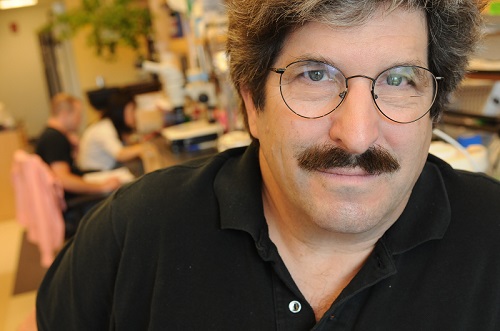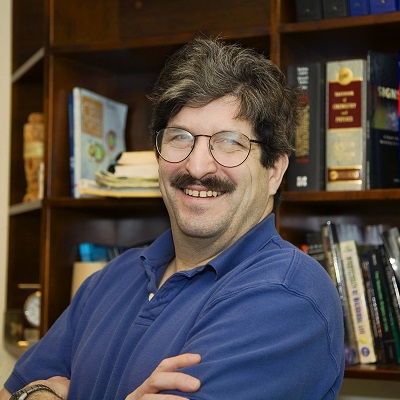Nobel Prize
Biography
 Gary Ruvkun, PhD, is a professor of genetics at Harvard Medical School and an investigator in Massachusetts General Hospital's Department of Molecular Biology. Ruvkun’s research has explored two major themes: microRNAs, which are the smallest genes, and the control of longevity and metabolism by endocrine pathways.
Gary Ruvkun, PhD, is a professor of genetics at Harvard Medical School and an investigator in Massachusetts General Hospital's Department of Molecular Biology. Ruvkun’s research has explored two major themes: microRNAs, which are the smallest genes, and the control of longevity and metabolism by endocrine pathways.
In 1993, Ruvkun and Victor Ambros, PhD, then at Harvard University, published back-to-back papers in the journal Cell. Ambros discovered that the regulatory product of the lin-4 gene was a 22-nucleotide-long RNA, and Ruvkun discovered the mechanism by which the lin-4 microRNA was able to suppress the translation of the lin-14 messenger RNA by binding directly to the mRNA itself. In 2000, Ruvkun discovered the second C. elegans microRNA, let-7, which also regulated its target mRNA by base-pairing directly to it. He also showed that the regulatory role of let-7 was not restricted to C. elegans but was evolutionarily conserved across the animal kingdom—including fruit flies, zebrafish, sea urchins and humans.
Genome analysis by hundreds of researchers over the intervening decades has produced a catalog of the thousands of microRNAs produced in animals and plants. Human microRNAs are now implicated in heart disease, in viral pathogenesis, in regulation of neural function and disease, and in the transition from totipotent stem cells into differentiated cells. Human therapies based on microRNA regulation are already in clinical trials for heart disease. In plants, microRNAs mediate a variety of developmental and physiological transitions and turn out to have been key players in the domestication of corn.
Small RNAs the same size as lin-4 and let-7 have subsequently been found to mediate gene repression by RNA interference (RNAi) and were shown by Ruvkun and others to use particular types of protein cofactors. Recently Ruvkun used comparative genomics of 500 complete genomes from animals, plants and fungi to discover protein-coding genes that have been retained or lost in evolution in concert with microRNA genes. The proteins with these evolutionary signatures mediate steps in how microRNAs and other small RNAs engage their mRNA targets. Some of these components may be developed as drug targets to enhance microRNA regulation in mammals, a technical improvement that may be necessary to elevate a laboratory tool to a therapeutic modality.
Ruvkun's laboratory has also discovered that an insulin-like signaling pathway controls metabolism and longevity in the tiny roundworm C. elegans. Recent insulin-signaling-mutant analyses in mice and humans have validated the applicability of these discoveries to other animals, and these findings should be important for the eventual treatment of diabetes, a disease of insulin signaling.

Ruvkun’s team has also used full-genome RNA interference screens to explore the complete set of genes that regulate aging and metabolism. Many of the gene inactivations that increase survival encode core-conserved elements of cells that are targeted by antibiotics produced by fungi and microbes. These core genetic pathways are monitored by the immune system for toxin and virulence factor inhibition so that a reduction in function is interpreted as a microbial attack. The immune surveillance endocrine states that are normally induced by poisons or by genetic variation in these surveillance pathways may underlie a variety of autoimmune and other diseases.
Ruvkun is a graduate of the University of California at Berkeley (AB Biophysics,1973) and Harvard University (PhD Biophysics, 1982). He was born in Berkeley, California, and grew up in Oakland and Piedmont. His father was an engineer, and his mother attended college while her three children were growing up, receiving her undergraduate degree in psychology the same year that Ruvkun graduated from high school. After graduating from Berkeley, he worked for a tree-planting cooperative in Oregon and traveled in Latin America for a year before heading to Harvard in 1976 for graduate study. There he worked with molecular geneticist Fred Ausubel, PhD, to study bacterial nitrogen fixation. After receiving his doctorate, Ruvkun was a member of the Harvard Society of Fellows and did postdoctoral research with Robert Horvitz, PhD, at MIT and Walter Gilbert, PhD, at Harvard. In Horvitz’s lab Ruvkun began studying the genetic pathways that control the developmental timing of C. elegans.
Ruvkun’s honors and awards include the National Academy of Sciences, the Institute of Medicine, the Rosenstiel Award (with Victor Ambros, Andy Fire, and Craig Mello), the Warren Triennial Prize (with Ambros), the Gairdner International Award (with Ambros), the Albert Lasker Award for Basic Medical Research (with Ambros and David Baulcombe), the Louisa Horwitz Prize (with Ambros), the Shaul and Meira Massry Prize (with Ambros), the Dan David Prize for Aging research (with Cynthia Kenyon), the Wolf Prize (with Ambros), the Gruber Prize (with Ambros and Baulcombe), the Breakthrough Prize in Life Sciences and the March of Dimes Prize in Developmental Biology (with Ambros).
Ruvkun lives in the Boston area with his wife, Natasha Staller, a professor of art history at Amherst College, and their daughter Victoria, in her last year of Dartmouth medical school.
Mass General Nobel Prize Laureates Throughout History
Here is a look at the Nobel Prize winners associated with Massachusetts General Hospital.
George R. Minot, MD
Dr. Minot trained at Mass General, and shared the Nobel Prize in Physiology or Medicine in 1934 with Drs. William P. Murphy of Peter Bent Brigham Hospital in Boston and George H. Whipple of the University of Rochester. They were honored for discovering a lifesaving liver treatment for pernicious anemia. Although Dr. Minot conducted much of his award-winning work while director of the then Boston City Hospital, he said the idea that something in food might help patients with pernicious anemia came to him as early as 1912 while serving as a house officer at Mass General.
Carl F. Cori, PhD
Dr. Cori was already a Nobel laureate when he came to Mass General in 1966 to head the hospital’s Enzyme Research Laboratory. Dr. Cori, his wife, Dr. Gerty T. Cori, and an Argentine scientist named Dr. Bernardo A. Houssay, jointly received the award in Physiology or Medicine in 1947 for shedding new light on one of the body’s most important basic mechanisms: how the body converts glycogen, a type of starch, into blood sugar. Dr. Cori joined Mass General after retiring as chief of the Department of Chemistry at Washington University School of Medicine in St. Louis.
Fritz A. Lipmann, MD, PhD
Dr. Lipmann was director of Mass General’s Biochemical Research Laboratory in the mid-1940s when he isolated a substance called coenzyme A, which aids the body in converting fatty acids, steroids, amino acids and hemoglobins into energy. The work made possible a dramatic expansion of metabolic chemistry. Dr. Lipmann shared the 1953 Nobel Prize for Physiology or Medicine with Sir Hans Krebs of Sheffield, England.
Gerald M. Edelman, MD, PhD
A former Mass General intern, Dr. Gerald M. Edelman, of Rockefeller University in New York, earned the 1972 Nobel Prize for Physiology or Medicine along with Dr. Rodney R. Porter of the University of Oxford in England. They made discoveries related to the chemical structures in antibodies, the body’s defense against bacteria and harmful viruses.
Michael S. Brown, MD, PhD, and Joseph L. Goldstein, MD
Two researchers who became friends while interns at Mass General in 1966, Dr. Michael S. Brown and Dr. Joseph L. Goldstein, won the Nobel Prize for Physiology or Medicine in 1985. Joint studies they conducted provided important new discoveries about cholesterol and its blocking effect on arteries supplying the heart’s blood. At the time of the award, the men held appointments at the University of Texas Health Science Center in Dallas.
Michael Bishop, MD
Dr. J. Michael Bishop and Dr. Harold E. Varmus, coworkers at the University of California School of Medicine in San Francisco, were honored with the Nobel Prize for Physiology or Medicine in 1989 for learning that normal cells contain genes capable of becoming cancer genes. A 1962 graduate of Harvard Medical School, Bishop worked as a research fellow in the Department of Pathology at Mass General.
Ferid Murad, MD, PhD
Dr. Ferid Murad used to walk the halls of the Mass General when he was a medical resident from 1965 to 1967. While at the University of Texas Medical School he—along with colleagues Robert Furchgott, PhD, and Louis Ignarro, PhD—received the 1998 Nobel Prize in Medicine for their work with nitric oxide (NO) as a signaling molecule.
Jack W. Szostak, PhD
Dr. Jack Szostak of the Mass General Department of Molecular Biology shared the 2009 Nobel Prize for Physiology or Medicine with Elizabeth H. Blackburn, PhD, of the University of California at San Francisco and Carol W. Greider, PhD, of the Johns Hopkins School of Medicine. They had predicted and subsequently discovered telomerase, an enzyme that builds and maintains the protective caps at the tips of chromosomes.
Ralph M. Steinman, MD
Ralph M. Steinman, MD, a former Mass General resident, was one of three winners of the 2011 Nobel Prize in Physiology or Medicine for his discovery of dendritic cells, which play a key role in activating and regulating adaptive immunity. This research laid the foundation for other breakthroughs in immunology and led to new treatments for cancer, infectious diseases and immune system disorders. Steinman's award was one of the few exceptions to the rule that Nobels are not awarded posthumously, since he died only three days before the award was announced.

